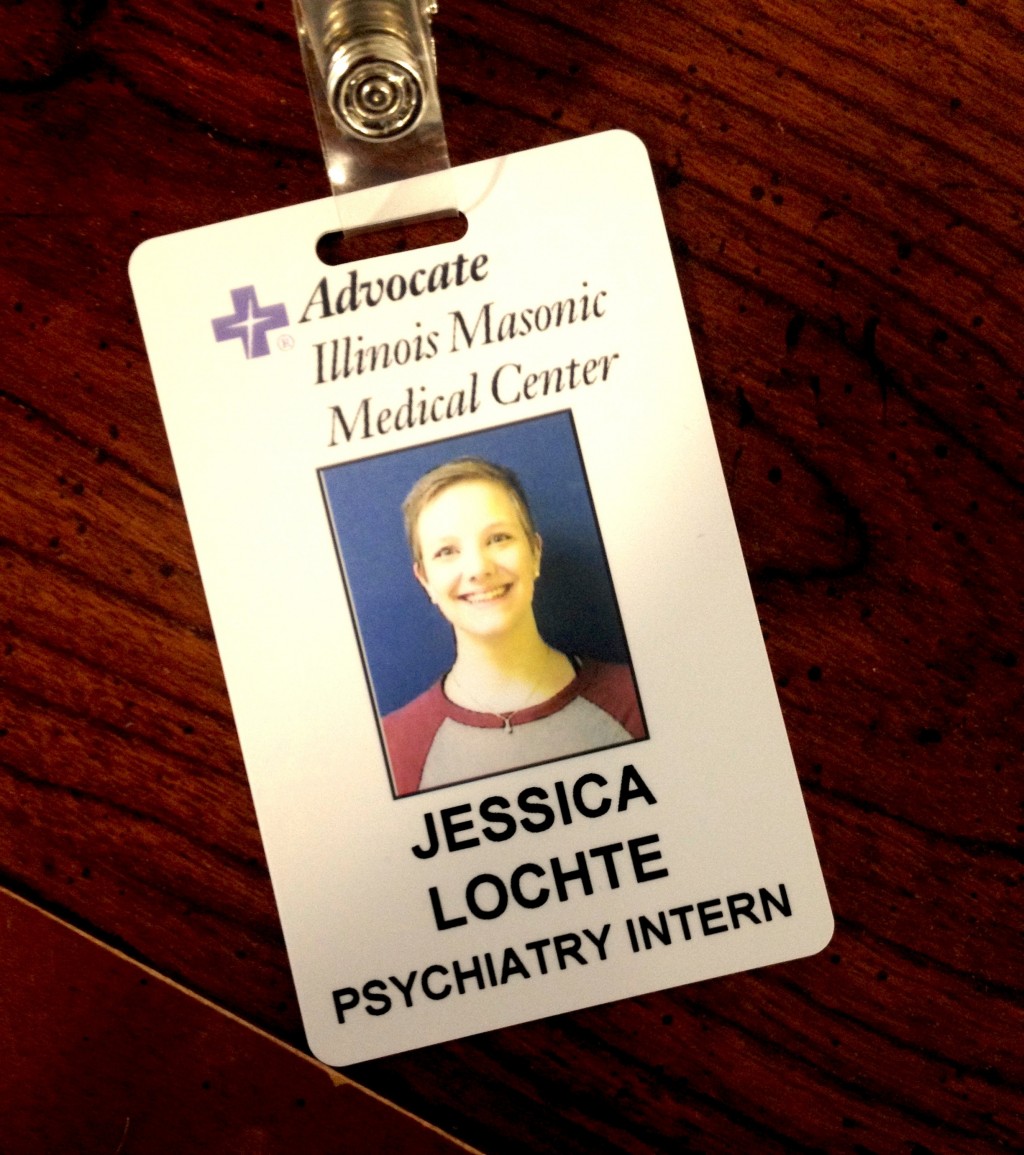
The Life of a DMT Intern on an Inpatient Psych Unit
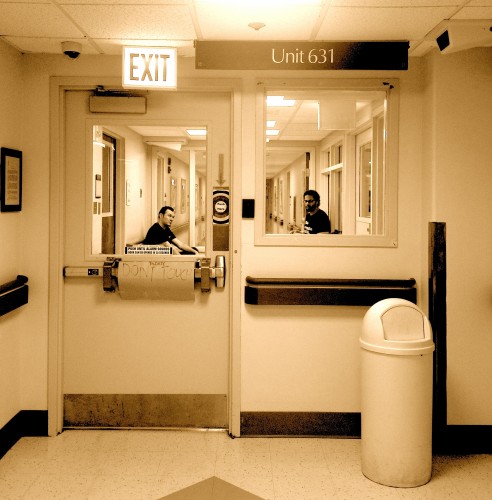
Unit 631
After introducing my work as a graduate assistant in my last blog post, I now want to give some insight into my life as an intern and what an internship in dance/movement therapy might look like.As part of Columbia’s curriculum, it is required for DMT&C students to gain practical experience through two “internships” during your two-year program. The first one (field placement) takes place twice a week during your second summer, in addition to classes (16 hours, 200h total). The second one (internship) is during your second year (Fall, Spring) usually three days a week (24 hours, 700h total).
With classes and my work as a graduate assistant I am not able to intern during the week, so I work 23 hours on the weekend (11.5 hours shifts on Saturday and Sunday). In summer, I did my field placement in a day-care facility for older adults with mild to moderate stages of dementia. As part of my internship, I am currently working at Advocate Illinois Masonic Medical Center on their inpatient psychiatric unit, Unit 631.
Unit 631 is a 34-bed inpatient psychiatric unit for adults, offering acute short-term treatment for clients who are either a danger to themselves or others (e.g. are homicidal, aggressive, or suicidal). Most of the time clients are self-admitted to the ER of the hospital, brought in by concerned family members or friends, or brought in by the CPD. Because it is an inpatient psych unit for adults, clients have to be at least 18 years old, but otherwise all ages 18+ are represented. I also get clients from diverse demographics, including different genders, sexual orientation, socioeconomic status, ethnicity, nationality, etc.
The unit is not specialized on specific disorders, so I work with a broad range of psychiatric diagnoses. However, the most prominent disorders are usually disorders on the schizophrenia spectrum, mood disorders, personality disorders, and all of them co-morbid with substance abuse/use. It is a closed unit, so nobody can leave or enter the floor without an access key.
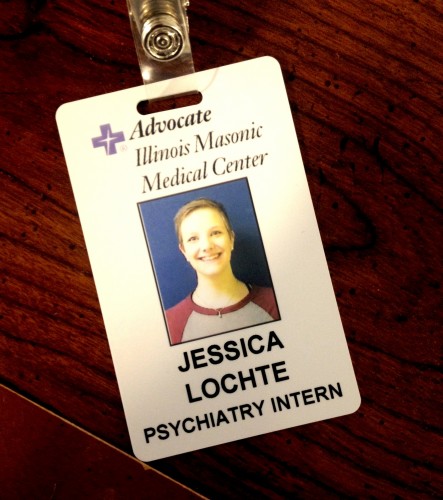
Access ID
So what does a typical day look like for me?
I arrive on the unit at 9 a.m. in the morning. At that point clients have just finished breakfast and a self-care group begins. Two counselors lead the roughly 60-minute group, during which clients are able to shave, put on makeup and nail polish, do their hair, and several other things to “freshen up.” I usually spend the time in our small office and the end of the hallway, reading up on new clients, getting a feeling for the overall mood on the unit, and picking the music that I would like to use in my dance/movement therapy group.
My supervisor Brandy comes in at 10 a.m. and around 10:30 a.m. we start our 60-minute dance/movement therapy group. I usually go in without any plan on what to work on and how to do it. You just never know who will participate in the group and which topics might come up. Everything that happens is made up and created in the moment.
In a typical DMT session, I would start with a short introduction, explaining in a couple of sentences what dance/movement therapy is about and inviting all participants to introduce themselves. I usually combine the verbal introduction of the participant with a body-related question, to start bringing awareness to the body-mind connection. For example, I might ask participants to say their name, how they are feeling today, and to name one thing/indicator in their body that tells them how they are feeling. Depending on the level of functioning in the group, I’ll adjust the introduction and might make it completely nonverbal.
Based on the responses of participants, I choose my music and start the “movement part” of the group. Now, this is the part that looks completely different in each group. Sometimes, just turning on the music gets participants moving and I can “pick up” their movement and deepen the experience. However, at other times even the music is not enough encouragement for participants to start moving, so I might do a more structured body scan or body part warm-up. In any way, I am trying to help the participants connect to their body; help them become aware of sensations, images, feelings or thoughts associated with specific movements; and change the emotional state they are in through movement. My hope is that at the end of the group, participants were able to experience “feeling save” and maybe a shift inside themselves. We close the group with a short discussion on experiences during the group.
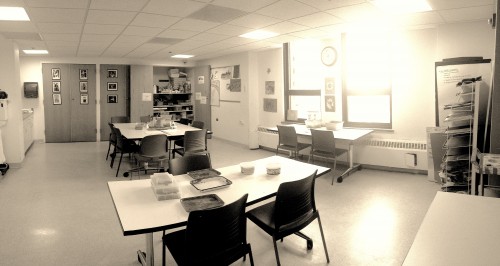
Expressive therapy room in which groups are held
After the group, clients have about a 90-minute lunch break, during which I write group notes and have my own little lunch break. From 1 p.m. to 3 p.m. the expressive therapy room is opened for Open Art, in which clients can engage in any form of visual art making (e.g. color coloring sheets, drawing, sculpturing with clay, etc). This is the main time when I can “hang out” with clients, check in with them on how they are doing, or have random conversations. It is also a time for me to recuperate with another chance to be creative.
From 3 p.m. to 4 p.m. we have shift change. Nurses and counselors from the day shift leave and the evening shift takes over. Clients are supposed to be in their rooms while most of the staff members meet and give an update on the unit. Usually, these meetings only take about 20 minutes. After that, Brandy and I complete individual intake assessments with clients who have been recently admitted and whose expressive therapy assessment have not been filled out yet. My individual assessment meetings look more like loose conversations about what brought the clients in, how they are doing, and what their goals might be. I use the verbal and nonverbal information to fill out the assessment after the meeting is over. Depending on the client, those meetings can take between 15 minutes and an hour (1.5 hours was the longest, and really exhausting).
At 6 p.m. Brandy and I lead an afternoon group, which also differs depending on the setup of the unit. We have done talk groups, art groups, meditation groups, inspirational groups, music listening, and karaoke. Sometimes we are opening up the “Library,” a small room with four computers for clients to check their emails, Facebook, listen to music on YouTube, or do anything else. And finally, from 7 p.m. to 8:30 p.m. we wrap up the day with group notes or hang out with clients in the hallway before going home.
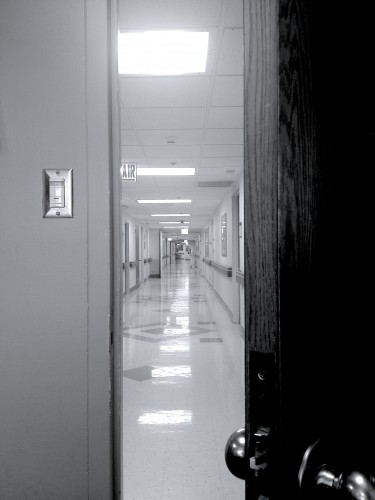
My view from our office down the hallway of Unit 631
Overall, I really enjoy working in an inpatient psych unit. I love hanging out with a diverse crowd of people, which applies both to the staff and the clients. A day on a psych unit is never the same and hardly ever boring. Clients rarely stay longer than 14 days, so when I come back on the weekend, most of the clients I met the last weekend were discharged.
It is an interesting challenge to lead a dance/movement therapy group with clients with a range of psychiatric disorders—establishing coherence is not an easy task. Of course, incidents happen when you work with this type of population and you have to be constantly aware of your surroundings, making sure that you keep yourself and others safe.
But overall I have met amazing and creative people on this unit and each client has taught me something new. Finally, there is always time to act “silly” either with my supervisor, other staff members, or my clients.
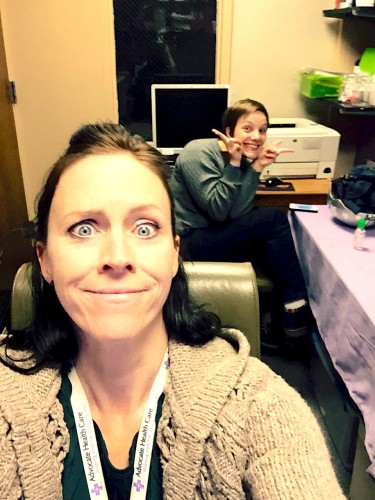
Fun times with my supervisor
